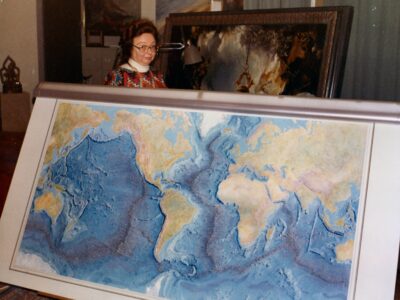
Photo credit: Bruce Gilbert
Marie Tharp, a pathbreaking oceanographic cartographer at the Lamont-Doherty Earth Observatory, co-creator of the first global map of the ocean floor and co-discoverer of the central rift valley that runs through the Mid-Atlantic Ridge died Wednesday August 23 in Nyack Hospital. She was 86.
A pioneer of modern oceanography, Tharp was the first to map the unseen topography of the ocean floor on a global scale. Her observations became crucial to the eventual acceptance of the theories of plate tectonics and continental drift in the earth sciences. Working with pens, ink and rulers, Tharp drew the underwater details, longitude degree by latitude degree, described by thousands of sonar readings taken by Columbia University researchers and others. Her maps have since become modern scientific and popular icons.
“I had a blank canvas to fill with extraordinary possibilities, a fascinating jigsaw puzzle to piece together,” Tharp said in an oral history interview conducted for the 50th anniversary of Lamont-Doherty in 1999. “It was a once-in-a-lifetime — a once-in-the-history-of-the-world — opportunity for anyone, but especially for a woman in the 1940s.”
Piecing together maps that they made, she and colleague Bruce Heezen revealed a 40,000-mile underwater ridge girdling the globe. With the discovery, they laid the foundation for later work that showed the sea floor spreads from central ridges and that the continents are in motion with respect to one another — a revolutionary and controversial theory among geologists at the time.
“I was so busy making maps I let them argue,” Tharp once said of the debates that swirled around her drafting table. “I figured I’d show them a picture of where the rift valley was and where it pulled apart. There’s truth to the old cliché that a picture is worth a thousand words and that seeing is believing.”
Tharp was born in 1920 in Ypsilanti, Michigan. As the daughter of a soil surveyor for the U.S. Department of Agriculture, she was constantly on the move — to the south in the winter months and north in the summer. By her own reckoning, she attended nearly two dozen schools by the time she graduated from high school. More importantly, she had also begun to get a feel for landscapes and mapmaking.

Tharp attended Ohio University, changing her focus several times until she graduated with majors in English and music and four minors. She later obtained a masters degree in geology from the University of Michigan and in math from the University of Tulsa. Yet, as Tharp said, she was “still searching for something more challenging,” and moved east, where she eventually joined the staff of the geology department at Columbia University in 1948 as a research assistant to Maurice “Doc” Ewing.
For the next several years, she sat at a desk plotting soundings of the ocean floor. When Tharp started piecing together the profiles, she noticed that it was not the line of mountains that formed the most continuous feature through the middle of the North Atlantic, but a cleft running down the center with peaks on each side. She thought it might be a rift valley like the one found in East Africa, an idea that would support the budding hypothesis that the continents move across the surface of the Earth. Heezen, who was then a graduate student, dismissed the idea as improbable to the point of being scientific heresy.
But the improbable soon proved probable. Other data showed large numbers of earthquakes occurring along the rift, confirming Tharp’s hunch. Based in part on the incontrovertible pictures she provided, the concept of plate tectonics moved into the realm of legitimate debate and later into the mainstream of earth science.
In 1959, Tharp and Heezen completed their first map of the North Atlantic. In 1961, they completed the South Atlantic and in 1964, the Indian Ocean. After Heezen died in 1977, Tharp focused her energy on completing a comprehensive view of the world’s oceans. The World Ocean Floor map was published later that year by the Office of Naval Research and is still in wide use today.

“Marie was the grand dame of ocean exploration,” said Bill Ryan, Doherty Senior Scholar at Lamont-Doherty and a long-time colleague of Tharp’s. “It is a very sad day, but we can also rejoice in how she so splendidly unveiled the hidden abyss. She didn’t just make maps; she understood how the Earth works.”
Only in recent years has Tharp begun to be recognized for the breadth and significance of her contributions to science. In 1998 she was honored during the 100th anniversary of the Library of Congress’ Geography and Map Division. The following year, she was recognized by the Woods Hole Oceanographic Institution. In 2001 she was honored by her home institution with the Lamont-Doherty Heritage Award. Today, a fellowship at Lamont-Doherty to promote women in science through the ADVANCE program bears her name.
“The significance of Tharp’s achievement and the importance of the maps cannot be overstated,” said Mike Purdy, director of Lamont-Doherty. “She was a pioneer in her science, playing a crucial role in the early days of sea-floor spreading research, and she was a pioneer in her profession, succeeding as a woman in a field dominated for decades by men. But most of all she was a wonderful person, a great colleague and a happy friend to so many of us.”
Tharp has no family, but is survived by her devoted staff. A celebration of her life and achievements will be held on Sunday September 17 at 2:00 p.m. at the Tappan Reform Church in Tappan, N.Y. In lieu of flowers, Tharp requested that donations be made to the Marie Tharp Fund at Lamont-Doherty. Plans for a symposium honoring her many contributions to the scientific community will be announced at a later date.



